|
FAQs about Identification of Faviid Corals
1
Related Articles: Faviid Corals,
Related FAQs: Faviid ID 2, Faviid ID 3, Faviid
ID 4 &, Faviids 1,
Faviids 2, Faviids 3, Faviid Behavior, Faviid Compatibility, Faviid Selection, Faviid Systems, Faviid Feeding, Faviid Disease, Faviid Reproduction/Propagation,
Stony/True Coral, Coral System Set-Up, Coral System Lighting, Stony Coral Identification, Stony Coral Selection, Coral Placement, Foods/Feeding/Nutrition, Disease/Health, Propagation, Growing Reef Corals,
Stony Coral
Behavior,
|
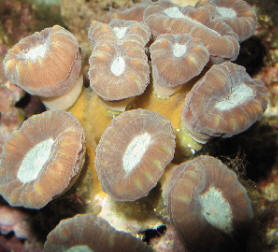
|
Coral Id...Perhaps Family
Faviidae 7/16/07 Crew, <Greetings! Mich is
your crewmember today!> Could you please help identify this
coral (please see attached photo)? <I see.> The LFS thought
it might be a flowerpot coral but from what I've been able to
see of flowerpot corals, they seem to extend much further and have
larger polyps then this does. <I am in agreement with you. I do
not think this is a flowerpot coral (Goniopora spp.). It can be
difficult and sometimes it is impossible to identify some coral
species without examining the coral skeleton. This may be the case
here. I suspect this may be part of the Family Faviidae. It could
be an Echinopora. The growth forms of Echinopora are highly
variable and may assume may shapes. It could also be a Montastrea
which are generally dome-shaped. But it well may be something else.
I'm sorry I can't give you a more definite answer.>
Thanks for your help <You're welcome!> and love the site.
<Glad to hear!
Cheers,
Mich> |
|
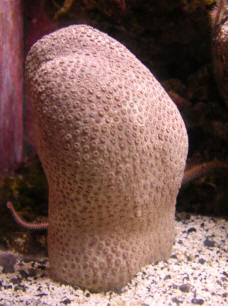
|
| Coral ID Favia and a Brain Coral
4/15/07 Hello I am Lucino from Roma. Can I know the species of
this coral? Thank you, ciao. <Ciao Lucino, Mich with you
today. Both corals are in the family Faviidae, one
appears to be of the genus Favia, identification to the species
level is barely possible when using taxonomic references to compare
skeletal structures, from a picture alone it is not
possible. The other coral appears to be a brain coral,
perhaps of the genus Leptoria or Platygyra. Hope that
helps. -Mich> |
|
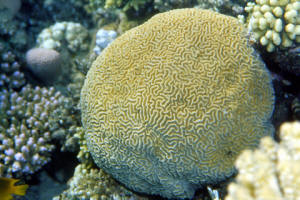 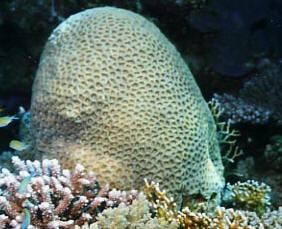
|
Brain corals... ID, care? 9/5/06 Hi
all, <James> I have a question regarding brain
corals. I have two of such in a 75G reef/fish
tank. I "know" that one is classified as a
Lobophyllia and the other, while I'm not certain, was sold to me as
a "brain coral". The one I'm certain of has
the hard central skeleton, it also inflates a VERY large and beautiful
soft polyp periphery. It's colors are light brown,
bluish, tan, and iridescent green (on the polyps and the
skeleton). This was purchased from my local
LFS. The other specimen was purchased from a large
online retailer and has the same basic shape, is purplish and white,
but only has the hard skeletal component and not the fleshy polyps.
<... all have a stony skeleton... variably fleshy polyps>
I know it's alive because it changes colors (to
mostly white) when disturbed and has several opening on it's
surface that open and close at regular intervals. Is
this specimen one that is not supposed to have fleshy polyps or have
they been retracted to reappear at some later time?
<Ahh, mostly/hopefully the latter> The stonier one I've had
for about three months and the other about two. Thanks in advance.
James p.s. if pics would help, they could be attached in another email.
<If you'd like a better shot at actual identification, please
send along. And please read here: http://www.wetwebmedia.com/faviidae.htm and the
linked files above. Bob Fenner>
| Live Rock hitchhiker coral ID 3/11/06 Hi, I'm trying
to identify a coral that is on one of my live rock. There are
several other life forms that I need to identify on my live rocks
but this one I really need to find out because this coral is not
happy right now. My tank is 29gallon FOWLR tank and I added some
live rocks about six months ago. This coral used to be well in my
tank at first. The polyps were extended and it was feeding on fish
food that landed on it, but now it is retracted and hardly ever
extends its polyps. I need to find out how to take care of this
coral. I've attached some pictures of it so please help me
identify this coral. <<Cladacora and Porites are probably the
most common live rock hitchhikers, and yours looks like
Cladacora. Despite it's brown color, this coral is
not photosynthetic and requires lots of food. Most
aquarists are unwilling or unable to provide enough food for it to
thrive.>> It has hard skeleton and when it is totally
retracted it looks like bee hive. At first few months, when it was
doing well, it grew about 50% of its original size but it stopped
growing and I can tell something is wrong with it.
<<Wow! It is surprise that it grew. Did
the slow down in growth coincide wit the introduction of
fish? It may be that the coral was getting live food in
the form of 'pods until you introduced other predators.>>
I have 4-24w T5HO lighting on my 29gallon so light is not on issue
I might think it was too bright. And I have lot of water movement
in the tank, over 1000 GPH turn over. <<Indeed, if anything,
I might suspect that the coral is not opening because of the bright
light. If possible, you might try moving it to a more shady
spot.>> Nitrate 0 Phosphate 0 Calcium 420mg/l Strontium
10mg/l Alkalinity 3.5meq/l maximum 1275mg/l PH 8.17 Please help.
Thanks, Hans <<Water tests all look good. Best
regards. AdamC.>> |
|
 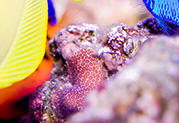 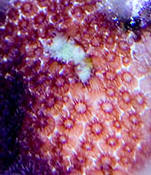
|
Coral ID and Econ. Lesson - Supply and Demand
11/14/05 Hey guys hope everything is going well, the far northeast
is really starting to get chilly!!! I had a quick question for you and
please take your time with your response if you're really busy. My
local LFS is always poor at identifying livestock they get in and they
have a LPS that they are selling as Favia sp. and feel it could
possibly be an Acanthastrea sp. (it is unlike any Favia I have seen for
sale) but am unsure of how to distinguish between the two.
<See J.E. Veron's works re... and the references beyond> It
is a rather large piece with many corallites and from the pictures on
the website, a few species of both genus <Genera> look rather
similar. I have never seen any Acanthastrea sp. in person which makes
possible obvious visual distinctions difficult for me. <A diverse
genus... morphologically and in terms of color> Most of the taxonomy
information in my textbooks deals with the physical coral skeleton and
bare corallites which is obviously the best and sometimes only means of
ID, and I understand the possible difficulty in taxonomy of coral from
a coral ecology class I took with Bob Steneck (are you familiar with
him?), <Nope> but these identification means are not so helpful
to me who wants this coral alive and fully intact! I also have
one more question about Acanthastrea sp. if you don't mind. Why
does this species command such a high price in the trade?
<Demand> My text books say it is a rather common species of coral
throughout much of the Indo-Pacific and eastern coast of Africa and am
confused to the correlation between common coral and high price. Thanks
for all your help, you guys are great. Matthew R. Tyree University of
Maine School of Marine Science <Mmm, your family name has a friend
in this field... Steve Tyree... Do look at/up Veron's works here.
Bob Fenner>
Coral (Favites) - 09/02/05 Hello crew,
<<Howdy>> Can you give me the common name and
scientific name of this coral I purchased a few weeks
ago? Picture is attached. <<Family-
Faviidae...Genus- Favites...Common Name(s)- Moon Coral, Pineapple
Coral, Honeycomb Coral, etc., etc.. Do have a look
around at CoralSearch re this coral (and many others!): http://whelk.aims.gov.au/coralsearch/coralsearch.php>>
First, the water tests show everything is in check. (0 Nitrates and
Phosphates even). I have been target feeding it daily a
mixture of frozen Phytoplankton and Cyclops-Eeze (Aquatic
Warehouse). <<The Cyclop-Eeze is fine, wouldn't waste
time/money with the phytoplankton. Fine-minced meaty
foods are best.>> It has been responding to the feeding less
and less, not opening up its mouths as much. <<Try some
finely minced shrimp, clam, etc.. I have also found
Sweetwater Plankton (http://www.customaquatic.com/customaquatic/brandsubcategory.asp?offset=96&brandid=SW&subcatID=fo-reef)
to be accepted by these corals.>> Also, I have 8 hours of 110
watts blue CF lighting and 3 hours of 350 watts MH lighting.
<<Don't know what else you have in this tank, but I would
increase the MH lighting to 8-12 hours per day.>> The coral
is not directly under one of the MH lights, more like in between,
approximately 10" deep or 14" from the actual MH
bulb. At first I had it directly under a light (6")
and the top of it started to turn white, hence I moved it down.
<<Yes, generally found in +30 feet of water. Try
placing near a rock ledge where it will receive less
"direct" MH lighting.. without shading it
completely.>> It still seems to be fading, but only on the
high ridges that get the most light. <<Likely still
stressed/damaged from light shock...should recover with time/proper
care.>> I just moved it 6 days ago. Is it too
early to tell if the move has helped? Should I be
worried about the feeding response? <<Probably too
early/still stressed as mentioned. Keep water parameters
optimum and try target feeding every two/three days with
fine-minced table shrimp for now.>> Thank you,
Michael Crean
<<Regards, EricR>> |
|
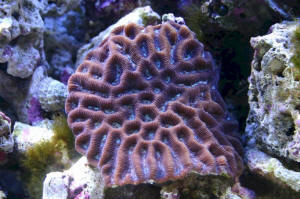
|
| <Induced> problems galore 8/16/05 my husband
bought this coral for his tank. neither of us have any
idea what it is because for some reason he always forgets to ask
the important questions. Today it was covered in brown
slimy stuff. he went to the LFS he got it at and told
them and all they said was "its dying" and to do an
iodine soak. i have attached a link to some pictures for
your viewing pleasure. is there anything else we should
do for this guy and what in the world is it???!!! <... a Faviid
of some sort...> http://photobucket.com/albums/v258/mousta/coral%20sickness/
if i need to attach the photos just let me know. thanks so much for
all your help Michelle <Please read here: http://www.wetwebmedia.com/faviidae.htm and on to
the linked files above re habitat, care... and please...
investigate before purchasing livestock. Bob Fenner> |
|
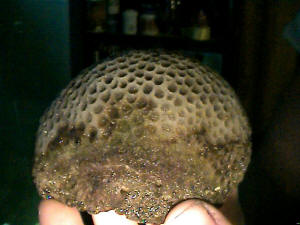
|
| Re: Induced problems galore 8/17/05 any idea what
the illness might be and how i might fix it? what should
i feed this? all the feeding in the FAQ is for different
corals than this. thanks, Michelle <... from the pix,
description, this colony is dead, or dying... from? Simple stress,
improper environment... Feeding is posted... by family. Bob
Fenner> |
Please identify Hey guys, I just want to say
that I own Reef Invertebrates and I constantly use it when I am
selecting inverts for my aquarium. Also, your FAQ
sections have helped me through more problems than I can remember,
thanks for keeping up such an awesome forum and valuable collection
of information. >>Thanks!>> I recently
purchased what I believe to be some kind of Acanthastrea, possibly
a lord. It looks very similar to the toxic Acan on
www.berlinmethod.com However, I am not sure and have
been told it is a Favia instead. Can you please help me
on making a definitive ID on my coral?? Thank you very
much, the pic is in the attachment. >>Hard to tell, can you
get a pic when the polyps aren't extended, so we can get a look
at the skeleton?>> Beau Phillips
>>Rich>> |
|

|
| Caulastrea laid an egg? 7/20/03 Hey Crew, I
have an interesting pic that I attached of what I believe to be an
egg or something being expelled by my candy cane coral. <the
picture is not clear enough for me to say for certain what it is.
By the large size of it, however, I can say that it isn't an
egg (by a scale of many magnitudes). It could be an air bubble from
excessive illumination (new lights, improved water clarity, carbon
change, etc that increased light suddenly in the tank). Or is could
be the beginnings of polyp ejection fro being stung by another
coral.> It started with a weird lump on one of the polyps for a
few days. I thought that maybe it was stung by a neighboring Torch
Coral. Then I was watching it and the green flesh in the
middle started to give way to what looked kind of like a shiny
pearl (egg?) It was quickly swept away in the current and I have no
idea where it went. <it could even be the product of digestion
from a large meal it caught> Is this in fact a spawning event
that took place? <alas, no> If so, I just added a moon light.
Maybe that had something to do with it? Thanks Angelo B. <the
moonlight is a very nice effect. Best regards, Anthony> |
|

|
Re: Candy Cane Coral: Polyp Bailout 7/16/03 Anthony: Thanks,
your reply makes total sense. I had a leather coral right next to it
which is what I suspected was the problem. I have since moved the Candy
Cane away. I also have just replaced my power compact light bulbs but I
think the bubble formed before that. I'll keep an eye on it.
<all good my friend> If the polyp does bail, is there anything I
can do at that point or will that "branch" die. <the
corallite (skeleton of that polyp) likely will not regenerate a new
polyp. For aesthetics, you may saw the dead branch away. The ejected
polyp will need to be isolated in a shallow cup or like vessel to keep
from blowing around. It will take some weeks/months to settle out but
may very well survive. No worries.. a very hardy coral. Anthony>
| The Wonders of Live Rock- coral ID
7/15/03 Dear Crew: As my LR matures (9 months), it gets more
and more interesting! I have attached 2 pictures of a
mat-like growth that I am hoping you will be able to
identify. It is slowly spreading, and I am
hoping/thinking it is a good thing. It is brown, with
patterned, moon-like craters throughout. The surface is
kind of hairy (best word I can think of), not
smooth. The smaller patches are near the larger
"mat". Any help you can provide, or any
direction you can point me in will be greatly
appreciated. Regards, Rich. <your creature is a
stony/Scleractinian Faviid coral. Appropriately called (common)
Moon coral (various species/genera). A very nice hitch-hiker
indeed! Best regards, Anthony> |
 |
 |
Faviid Growth on LR - Follow-up - 7/18/2003 Anthony: Thanks
for the information on my new Faviid coral growth. A few
follow-up questions, if I may: 1. I am now wondering, does this mean I
have an SPS tank now? <no my friend.. the encrusting
brain coral that you have is a large polyped species. Often needing
only moderate light and water flow like many softies... and quite
unlike the popular SPS corals> I have not purchased any corals yet,
I am still researching. I have a 10-month old 55 gallon (48x13x21)
glass, 130w PC, 4" DSB, BakPak2, 2 converging power heads, 2x
weekly 5% water changes. I currently have 1-Fire Goby,
1-Yellow Clown Goby, 1-False Percula Clown (no anemone, thanks to you
guys), 1-Orchid Dottyback, 1-Mithrax Crab, 2-Peppermint Shrimp, some
hermits & snails. 2. Is it true that I am doing something good to
help this creature grow from visibly nothing to a couple of inches
across, or is it one of those "hey look at me!, too bad I
can't survive here :(" scenarios? <nope... quite likely
improved by your good husbandry. And they can be quite hardy and
long-lived too. Easily over a decade captive is likely/possible> As
I am referencing your BOCP, it looks as though my coral is a Favites
because of it's "shared wall" appearance.
<really tough to say for how small it is and looking at a pic only.
It may not even be Favia or Favites, but rather another related
"brain" coral> Also, This particular specimen is brown,
and it formed on the side of the rock in a shady area, suggesting it is
a "deeper water" species, yes?. <quite possible> 3.
should I leave it where it is growing, or try to improve it's
position? <nope... best success is to leave it be where it has
struggled to adapt. No more stresses please by a move> The reason I
ask #3 is that, and I am still in fish-stocking mode. This
means I am still moving rocks around when a new arrival is presented,
and I want to be mindful of what is growing in its current position.
<hmmm... its a very bad habit with living corals... do resist> 4.
will acclimation to a brightly lit position turn it more colorful, or
WYSIWYG? <not necessarily. It may simply be naturally brown. And its
too young/unstable for a move at any rate> 5. since I didn't
find, nor did I expect to, a picture of my Favites on your site, would
you point me to somewhere else to try to match it to a species (I can
dream, can't I)? <books by Veron or Borneman would be great>
Again, I want to say thank you to all of the people who contribute to
make this website the finest place for wet pet
information. I will remain a fan/participant/supporter for
as long as you folks are around. Regards, Rich <thanks
for your support and inspiration, my friend. Be chatting soon.
Anthony>
RE: Hey Bob ;) (new Wrasse, brain coral...) Good to know
you're back, my friend! <Good to be back> I hope things were
good with your travel. And that you are able to catch up on what
I'm sure is a hug pile of queries from all of those persons you so
generously offer your services. <Yes> So here's the
situation. I just had a birthday yesterday. My girlfriend (bless her
heart) knows almost nothing about salt water aquaria, but she does
support my passion and attempts to help as much as she can. So for my
birthday she got me a BEAUTIFUL "Scott's Fairy Wrasse"
from FFE and a piece of unidentified Stony Coral. I know nothing about
either of these animals . . . <The Cirrhilabrus is a real winner.
Our coverage: http://wetwebmedia.com/cirrhilabrus.htm The coral a bit
worrisome... and happy birthday> Currently my tank looks great the
refugium already has some nice algal colonies brewing. Here's the
problem. I have a huge piece of brain coral in there that had looked
AWESOME for a few days and now it is about half the size. . . I was
planning on adding nothing to the tank for at least a few weeks to let
things settle. Now I have added stock (by no plan of my own) and there
is bound to be another ammonia spike. To the best of my knowledge all
parameters are perfect. Everything else looks great. . . Have I lost
this guy? He still has some color, but again, he's half the size.
<A brain coral that has shrunk halfway? Please take a look over the
stony coral sections on WWM... for closer identification> At one
point he was so enormous (like 6-8 inches across), colorful and even
had tentacles coming out of him?!?!?! It was great. I don't want to
lose this guy. Oh also, my temp has spiked up to the likes of 83-85
degrees these past few days. Could this be it? <A contributing
cause> Thanks for getting back to me. Oh, and I took out that Cuke.
Shortly after the water cleared up and things returned to normal. <A
close one.> Talk to you soon, and have an awesome day! <You as
well. Bob Fenner>
| Rose coral (Manicina areolata)
Hi Anthony, What do you think of this coral? <a wonderful
species... should be legal to collect but isn't. We have to
simply luck out and get them on live rock> Picture 1- Rose Coral
is 5 weeks after I got it as a hitchhiker on Carib. LR Picture
2-Rose Coral is 5 weeks later, same specimen. <little growth,
but good acclimatization and polyp extension. Needs fed at night
when modified feeding polyps come out... can be coaxed by day>
You IDed this coral, anymore particulars? <Hmm.... not sure what
else you'd like or are looking for. Care and feeding is just
like the pacific Trachyphyllia open brain species except Manicina
tolerates much brighter light. Feeding 3-5 times weekly is a
minimum> Thanks so much, Mike <best regards, my friend. Do
enjoy this little gem! Anthony> |
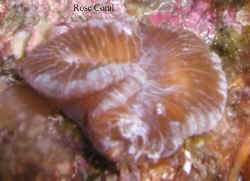 |
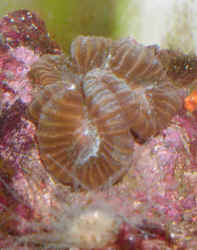 |
| Coral ID: Faviidae... a Favia or a Favites?
Wanted to know the name, lighting and feeding requirements of this
coral before I go out and buy one. Reading from your site I believe
its from the family Faviidae. Also I read that they need a good
amount to moderate lighting. Is this correct? Not sure on the
feeding requirements though? <the coral pictured is a Faviid,
specifically a Favites species. You can tell the difference among
Faviids as Favites has shared (melded) polyp walls while Favia
species have distinct walls (separate from each other). They are
adaptable to a wide range of light but are inclined to brighter
schemes. Keep in the top 10" of water under any fluorescents
and please acclimate slowly to all lighting (especially when new
and to MH) after a 2-4 week quarantine in your separate isolation
tank (before entering the main display). There are articles on QT
for corals and on acclimating corals to new lighting in the
archives. Feeding very finely minced meaty foods will be necessary
1-3 times weekly or more if lights are weak. Mysids and Gammarus
are very fine. Pacifica plankton too. Water flow should be moderate
to strong but never laminar. Best regards, Anthony> |
|

|
Brain Coral ID Thanks Anthony, <welcome, my friend>
found some pictures of the Blastomussa species and this one is
definitely a Faviid, found a picture of it too!, so I'll put it on
the top 3rd of the tanks, seems to be doing good so far,
<excellent homework!> the 4 loose mushrooms that I put in
yesterday are doing amazingly well, they look a lot better in my tank
then they did at the store!!... I'll see what Zoo Plankton I can
find! <great... do consider Mysid shrimp, Pacifica plankton for
fresh frozen, and culturing some baby brine live for most/all corals on
occasion. A good fish-less plankton generating refugium would be pretty
cool to> Thanks again David
<kindly, Anthony>
|
|

